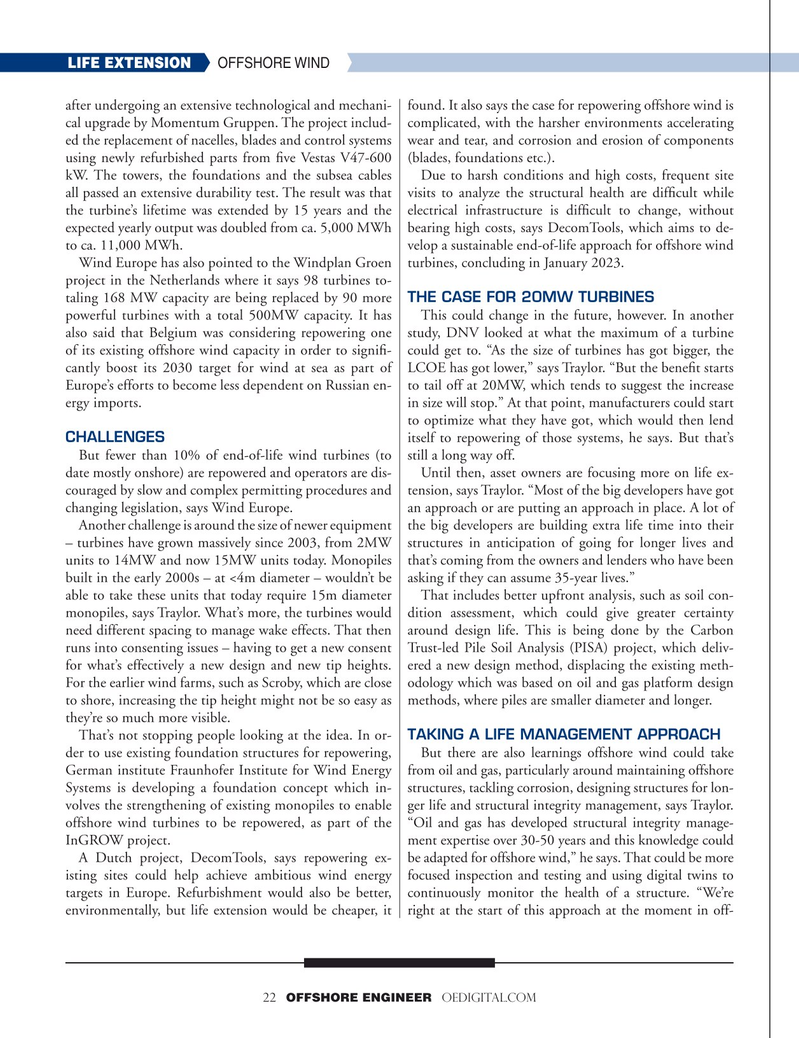
Page 22: of Offshore Engineer Magazine (Sep/Oct 2022)
Read this page in Pdf, Flash or Html5 edition of Sep/Oct 2022 Offshore Engineer Magazine
LIFE EXTENSION OFFSHORE WIND after undergoing an extensive technological and mechani- found. It also says the case for repowering offshore wind is cal upgrade by Momentum Gruppen. The project includ- complicated, with the harsher environments accelerating ed the replacement of nacelles, blades and control systems wear and tear, and corrosion and erosion of components using newly refurbished parts from fve Vestas V47-600 (blades, foundations etc.). kW. The towers, the foundations and the subsea cables Due to harsh conditions and high costs, frequent site all passed an extensive durability test. The result was that visits to analyze the structural health are diffcult while the turbine’s lifetime was extended by 15 years and the electrical infrastructure is diffcult to change, without expected yearly output was doubled from ca. 5,000 MWh bearing high costs, says DecomTools, which aims to de- to ca. 11,000 MWh. velop a sustainable end-of-life approach for offshore wind
Wind Europe has also pointed to the Windplan Groen turbines, concluding in January 2023.
project in the Netherlands where it says 98 turbines to- taling 168 MW capacity are being replaced by 90 more THE CASE FOR 20MW TURBINES powerful turbines with a total 500MW capacity. It has This could change in the future, however. In another also said that Belgium was considering repowering one study, DNV looked at what the maximum of a turbine of its existing offshore wind capacity in order to signif- could get to. “As the size of turbines has got bigger, the cantly boost its 2030 target for wind at sea as part of LCOE has got lower,” says Traylor. “But the beneft starts
Europe’s efforts to become less dependent on Russian en- to tail off at 20MW, which tends to suggest the increase ergy imports. in size will stop.” At that point, manufacturers could start to optimize what they have got, which would then lend
CHALLENGES itself to repowering of those systems, he says. But that’s
But fewer than 10% of end-of-life wind turbines (to still a long way off.
date mostly onshore) are repowered and operators are dis- Until then, asset owners are focusing more on life ex- couraged by slow and complex permitting procedures and tension, says Traylor. “Most of the big developers have got changing legislation, says Wind Europe. an approach or are putting an approach in place. A lot of
Another challenge is around the size of newer equipment the big developers are building extra life time into their – turbines have grown massively since 2003, from 2MW structures in anticipation of going for longer lives and units to 14MW and now 15MW units today. Monopiles that’s coming from the owners and lenders who have been built in the early 2000s – at <4m diameter – wouldn’t be asking if they can assume 35-year lives.” able to take these units that today require 15m diameter That includes better upfront analysis, such as soil con- monopiles, says Traylor. What’s more, the turbines would dition assessment, which could give greater certainty need different spacing to manage wake effects. That then around design life. This is being done by the Carbon runs into consenting issues – having to get a new consent Trust-led Pile Soil Analysis (PISA) project, which deliv- for what’s effectively a new design and new tip heights. ered a new design method, displacing the existing meth-
For the earlier wind farms, such as Scroby, which are close odology which was based on oil and gas platform design to shore, increasing the tip height might not be so easy as methods, where piles are smaller diameter and longer. they’re so much more visible.
That’s not stopping people looking at the idea. In or- TAKING A LIFE MANAGEMENT APPROACH der to use existing foundation structures for repowering, But there are also learnings offshore wind could take
German institute Fraunhofer Institute for Wind Energy from oil and gas, particularly around maintaining offshore
Systems is developing a foundation concept which in- structures, tackling corrosion, designing structures for lon- volves the strengthening of existing monopiles to enable ger life and structural integrity management, says Traylor. offshore wind turbines to be repowered, as part of the “Oil and gas has developed structural integrity manage-
InGROW project. ment expertise over 30-50 years and this knowledge could
A Dutch project, DecomTools, says repowering ex- be adapted for offshore wind,” he says. That could be more isting sites could help achieve ambitious wind energy focused inspection and testing and using digital twins to targets in Europe. Refurbishment would also be better, continuously monitor the health of a structure. “We’re environmentally, but life extension would be cheaper, it right at the start of this approach at the moment in off- 22 OFFSHORE ENGINEER OEDIGITAL.COM

 21
21

 23
23